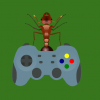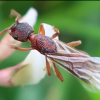Location: A park in Las Vegas
More precise location: Grassy area, but in those little empty patches
When: May 27
Time: Around 5:00 PM
Other Characteristics: I think it has a stinger, or a acidopole. This is because when I tried removing the cotton ball, it was near it, and either tried to sting it, or formic acid spray it. Sorry if I used acidopole in a wrong way, since I literally just learned about it.
It also has a thin gaster, but like I said I got this queen in late May, so it has already laid eggs. But right after I put it into a test tube, it laid some eggs, so I'm not really sure about it being semi-claustral, or fully-claustral.
I have a video, and a few pictures of it right here:
Here's a picture that isn't mine, but the Queen looks like this worker:
http://www.ispotnature.org/node/809072
Here's the video:
Thanks! Much appreciated!
Edited by Ender Ants, June 6 2017 - 4:32 PM.























